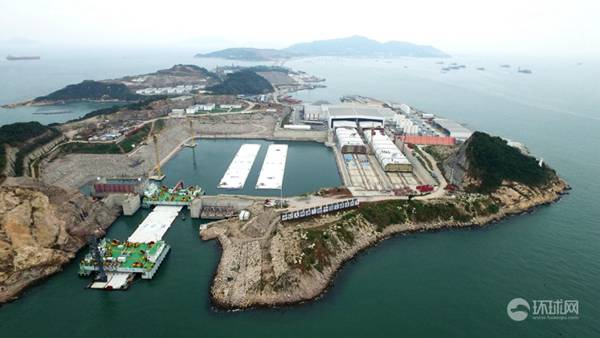

China has made great progress in bridge construction in recent years. The ongoing construction of the Hong Kong–Zhuhai-Macao Bridge and the second Humen Bridge, are two good examples.
The second Humen Bridge, which is 12.89 kilometers long, is designed to handle 140,000 vehicles a day. The new link across the Pearl River is set to ease traffic on the Humen Bridge currently in operation.

The second Humen Bridge, with a total length of 12.89 kilometers, is designed to handle 140,000 vehicles a day. Photo by Global Times
Ge Yaojun, vice chairman of the International Association for Bridge and Structural Engineering, said China was now the world’s leader in terms of bridge-building technology. He made the remark last year while visiting the second Humen Bridge under construction.
The bridge, built by the Second Harbour Engineering Company Ltd, under China Communications Construction Company, has tackled many technological barriers.
The bridge’s main cables are firmly held like in a tug of war by two gigantic concrete blocks with total weight equal to nine Liaoning aircraft carriers. Each main cable, which is 2,170 meters long and 85.1 centimeters in diameter, consists of 42,926 steel wires.
Drones were used to deliver a pilot rope to connect two sides of the bridge, said Yang Min, deputy manager of the S2 section of the bridge. Construction workers have now gotten used to the height because every day they have to do catwalk on the 1.2- kilometer distance, which is 60 to 191 meters above sea level.
The S3 section or the approach bridge is 40 meters above sea level. To build the bridge, an erecting crane was first used to put together and reinforce 12 small blocks weighing 140 tons. The enormous block was then lifted to pave the deck of the bridge.
The error margin was reduced to 5 millimeters. Based on the precision, Chinese engineers have improved bridge-building craft in a bid to speed up construction. Workers now pave 45 meters in 10 days, using innovated technology. In Europe, it takes 15 to 18 days to finish the same area.
Two erecting cranes, one imported and the other domestically-built, were used to build the bridge. The home-made piece of equipment, costing RMB 50 million - half the price of the imported one - outperformed the latter in the construction process, a construction worker said.

Construction of the Hong Kong–Zhuhai-Macao Bridge. Photo by Global Times
Construction of the Hong Kong–Zhuhai-Macao Bridge running between two artificial islands and a tunnel is the core and control project seen as very challenging. Engineers have had to overcome one of the most complex challenges ever in the world to complete the project.
Meanwhile, the ecological systems on the two islands remain undisturbed by the world-class construction.
The bridge’s tunnel, which is 6.7 kilometers long, submerges into the water at a maximum depth of 50 meters. It is connected by 33 pipelines with a total cross section equal to the size of a tennis court. The margin of error was reduced to a centimeter.
The E-29 and E-30 sinking pipelines, which were installed in May, are perfectly connected, according to Chen Xiangyang, an official with the tunnel project.
The tunnel has contributed 64 technical innovations in areas such as pipeline pavement and connection. The technique is currently mastered by a small number of countries such as the Netherlands, Germany, the U.S. and Japan.
Hans de Wit, a Dutch tunnel expert, believes the bridge is a "successful project with the highest quality around the globe." His team has been working together with the bridge management bureau since 2008.
Japanese tunnel expert, Hanada Yukio, admits that Japan does not have a project with such a long distance of sinking tunnel. Japanese companies give more consideration to how to make profits while Chinese engineers lay emphasis on tackling technical difficulties, he added. Hanada Yukio has been working in China for 6 years.
“Chinese engineers have developed many techniques for their country. I’ll tell my friends that Chinese people are really amazing and China will make some remarkable achievements in future,” Hanada Yukio said.
 Fire brigade in Shanghai holds group wedding
Fire brigade in Shanghai holds group wedding Tourists enjoy ice sculptures in Datan Town, north China
Tourists enjoy ice sculptures in Datan Town, north China Sunset scenery of Dayan Pagoda in Xi'an
Sunset scenery of Dayan Pagoda in Xi'an Tourists have fun at scenic spot in Nanlong Town, NW China
Tourists have fun at scenic spot in Nanlong Town, NW China Harbin attracts tourists by making best use of ice in winter
Harbin attracts tourists by making best use of ice in winter In pics: FIS Alpine Ski Women's World Cup Slalom
In pics: FIS Alpine Ski Women's World Cup Slalom Black-necked cranes rest at reservoir in Lhunzhub County, Lhasa
Black-necked cranes rest at reservoir in Lhunzhub County, Lhasa China's FAST telescope will be available to foreign scientists in April
China's FAST telescope will be available to foreign scientists in April "She power" plays indispensable role in poverty alleviation
"She power" plays indispensable role in poverty alleviation Top 10 world news events of People's Daily in 2020
Top 10 world news events of People's Daily in 2020 Top 10 China news events of People's Daily in 2020
Top 10 China news events of People's Daily in 2020 Top 10 media buzzwords of 2020
Top 10 media buzzwords of 2020 Year-ender:10 major tourism stories of 2020
Year-ender:10 major tourism stories of 2020 No interference in Venezuelan issues
No interference in Venezuelan issues
 Biz prepares for trade spat
Biz prepares for trade spat
 Broadcasting Continent
Broadcasting Continent Australia wins Chinese CEOs as US loses
Australia wins Chinese CEOs as US loses